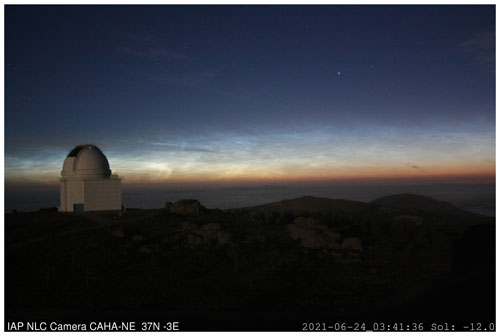the Creative Commons Attribution 4.0 License.
the Creative Commons Attribution 4.0 License.
On the colour of noctilucent clouds
Anna Lange
Gerd Baumgarten
Alexei Rozanov
Christian von Savigny
The high-latitude phenomenon of noctilucent clouds (NLCs) is characterised by a silvery-blue or pale blue colour. In this study, we employ the radiative transfer model SCIATRAN to simulate spectra of solar radiation scattered by NLCs for a ground-based observer and assuming spherical NLC particles. To determine the resulting colours of NLCs in an objective way, the CIE (International Commission on Illumination) colour-matching functions and chromaticity values are used. Different processes and parameters potentially affecting the colour of NLCs are investigated, i.e. the size of the NLC particles, the abundance of middle atmospheric O3 and the importance of multiply scattered solar radiation. We affirm previous research indicating that solar radiation absorption in the O3 Chappuis bands can have a significant effect on the colour of the NLCs. A new result of this study is that for sufficiently large NLC optical depths and for specific viewing geometries, O3 plays only a minor role for the blueish colour of NLCs. The simulations also show that the size of the NLC particles affects the colour of the clouds. Cloud particles of unrealistically large sizes can lead to a reddish colour. Furthermore, the simulations show that the contribution of multiple scattering to the total scattering is only of minor importance, providing additional justification for the earlier studies on this topic, which were all based on the single-scattering approximation.
- Article
(5994 KB) - Full-text XML
- BibTeX
- EndNote
Noctilucent clouds (NLCs), also known as polar mesospheric clouds (PMCs), occur at latitudes poleward of about 50∘ in the summer hemisphere at altitudes between about 80 and 85 km, slightly below the high-latitude summer mesopause (e.g. Rapp and Thomas, 2006). The low temperature and a sufficient amount of water vapour at the summer mesopause lead to the formation of optically thin ice clouds (e.g. Gadsden and Schröder, 1989; Thomas et al., 1995; Baumgarten and Fiedler, 2008; von Savigny et al., 2020). NLCs were first reported by Backhouse (1885) and Leslie (1885) in 1885, 2 years after the Krakatoa volcanic eruption in 1883.
Because they are very tenuous clouds, with vertical optical depths of typically (Debrestian et al., 1997), they can only be seen during twilight when the Sun is between 6 and 16∘ below the horizon (and the clouds are still sunlit) while the observer and the atmosphere below the clouds are in darkness (Avaste et al., 1980; Thomas, 1991). NLCs appear “silvery”, “pearly” and generally have a blue tint (Currie, 1962; Paton, 1964; Fogle, 1966). Figure 1 shows a typical example of an NLC with a blueish colour. Typical particle radii of visible NLCs are about 10–80 nm (e.g. Gumbel and Witt, 1998; von Savigny et al., 2005; Baumgarten and Fiedler, 2008; Robert et al., 2009), so they are smaller than the wavelength of visible radiation and therefore preferentially scatter the short-wave blue light. Selective absorption of longer wavelengths in the Chappuis bands of ozone is also important for the colour of NLCs (Gadsden, 1975a). Hulburt's 1953 paper demonstrated that ozone absorption must be taken into account for the correct modelling of colours and spectra of the twilight sky, including the zenith (Hulburt, 1953). Studies on the colours of NLCs are also found in the papers of Gadsden (1975b) and Ostdiek and Thomas (1993). Gadsden analysed spectral radiance and small-field spectral polarisation measurements and highlighted ozone as a decisive factor influencing the colour of NLCs (Gadsden, 1975b). In contrast, Ostdiek and Thomas investigated the influence of two different cloud particle size distributions on the colour (chromaticity values) of NLCs (Ostdiek and Thomas, 1993). In the current work, the impact of several parameters that potentially influence the colour of NLCs is investigated. This includes the effect of ozone, the NLC particle size and the contribution of multiply scattered solar radiation. For this study, we use the radiative transfer model SCIATRAN developed by the Institute of Environmental Physics at the University of Bremen, Germany (Rozanov et al., 2014). Furthermore, the colours corresponding to the calculated spectra are determined and displayed using a standard approach, based on the CIE XYZ colour system (Wyszecki and Stiles, 2000; CIE, 2004) and the sRGB colour space.
The paper is structured as follows. In Sect. 2 we introduce the main features of the SCIATRAN radiative transfer model relevant to this study, as well as the colour modelling approach employed here. Section 3 presents the main results, i.e. the dependence of the colour of NLCs on the abundance of stratospheric ozone, on the NLC particle size and other parameters. The main implications and limitations of the results are discussed in Sect. 4, and conclusions are presented in Sect. 5.
2.1 Radiative transfer simulations: SCIATRAN with incorporated Mie code
To model the sunlight scattered by NLC particles and transmitted to the Earth's surface, the Mie code implemented into the radiative transfer software SCIATRAN was used. This allows for the calculation of aerosol optical parameters by SCIATRAN and the simultaneous implementation as an aerosol layer at a certain height. The NLC particle size distribution was assumed to be a mono-modal log-normal distribution:
where N0 is the total particle number density, rm the median radius, r the particle radius and S the geometric standard deviation of the distribution (Grainger, 2017). The calculations were carried out for median radii ranging from 10 to 1000 nm and constant values for S=1.4 and N0=100 cm−3. Note that the vertical optical depth of the cloud layer is additionally specified, which leads to an adjustment of the value of N0. The input values were guided by previous studies and literature on this topic (e.g. Gadsden and Schröder, 1989; Baumgarten and Fiedler, 2008; Baumgarten et al., 2010). In order to simulate the solar radiation scattered by aerosols and air molecules in a spherical atmosphere, while considering refraction effects for the direct solar beam and the scattered light, the “spher_scat” mode was used in SCIATRAN (Rozanov et al., 2014). SCIATRAN was developed by the Institute of Environmental Physics (IUP) of the University of Bremen as a forward model for the retrieval of atmospheric parameters from measurements with the SCIAMACHY instrument on ESA's Envisat spacecraft. More information on SCIATRAN can be found at https://www.iup.uni-bremen.de/sciatran/ (last access: 29 April 2022). The model output contains radiance values at different wavelengths. These data were multiplied by the solar spectrum incident on the Earth's atmosphere (SORCE data (Solar Radiation and Climate Experiment)) (LASP, 2003) to obtain the resulting spectral distribution of the solar radiation scattered to an observer at the Earth's surface.
2.2 Colour modelling
The colour corresponding to a given scattered solar spectrum was determined and displayed using a standard approach based on the CIE XYZ colour space established in 1931 (e.g. Wyszecki and Stiles, 2000; CIE, 2004; Brainard and Stockman, 2010). Using the CIE colour-matching functions , and after Judd (1951) and Vos (1978), which quantify the spectral sensitivity of the three cone cells of the human eye, the CIE tristimulus values X, Y and Z are determined (Billmeyer Jr. and Fairman, 1987):
where I(λ) is the given radiance spectrum, and the normalising factor k is defined as
with Iachromatic(λ) as a reference spectrum with the colour impression of white. In the case of self-luminaries, k remains indeterminate. Based on the XYZ tristimulus values, the CIE chromaticity values x and y are calculated using
These chromaticity values characterise the colour independently of the brightness and are displayed in a 2-D plot, the so-called CIE chromaticity diagram or “gamut”. Furthermore, the XYZ tristimulus values were converted to sRGB (standard RGB), which can be used to display the colours in the programming software IDL (Interactive Data Language). More detailed information can be found in a previous paper by Wullenweber et al. (2021).
For the radiative transfer simulations carried out in this work, SCIATRAN version 4.1.3 (Rozanov et al., 2014) is used. Standard atmospheric trace gas profiles (including H2O, O3, O2, CO2, SO2, NO3 and N2O) are used, as well as pressure and temperature profiles for high mid-latitudes taken from a climatological database obtained from a 3-D CTM (chemical transport model) developed at the University of Bremen (Sinnhuber et al., 2003). In addition, the “DOM_S” (scalar computation) setting is used, which means that the radiative transfer equation is solved with a scalar discrete ordinate approach (Rozanov et al., 2014) and with “the number of iterations” =1, and an approximate treatment of multiple scattering is performed. This mode is referred to as the approximate spherical solution. The errors resulting from this simplified treatment are small, as further discussed in Sect. 3.5. Figure 2 illustrates the viewing geometry in SCIATRAN, which is essentially defined by three angles: the solar zenith angle (SZA), the solar azimuth angle (SAA) and the viewing zenith angle (VZA) (in ∘). The viewing zenith angle defines the line-of-sight angle at the observer position with a maximum value of 90∘ for a ground-based observer. That means at a VZA of 0∘ the imaginary observer looks to the zenith and at 90∘ to the horizon. The solar azimuth angle describes the azimuth angle of the Sun's position with respect to the viewing direction. The value of 0∘ corresponds to the solar direction, and the value of 180∘ to the anti-solar direction. At this point it should be noted that due to the azimuthal symmetry in SCIATRAN, the values between 180 and 360∘ describe the same viewing geometry as the corresponding values between 180 and 0∘ (Rozanov et al., 2014). With these three angles, it is therefore possible to specify the geometry based on the position of the Sun and the observer.
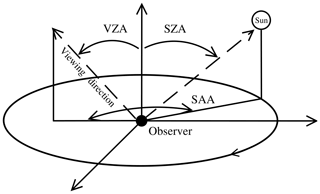
Figure 2Definition of the viewing geometry in SCIATRAN, with SZA (solar zenith angle), VZA (viewing zenith angle) and SAA (solar azimuth angle).
3.1 Impact of the NLC optical depth
Figure 3 shows scattered solar spectra determined by multiplying the SORCE solar spectrum (LASP, 2003) by the scattered radiance spectra simulated with SCIATRAN. The left panel of Fig. 3 includes an NLC with the following characteristics: rm=50 nm, S=1.4, vertical optical depth of , 1 km vertical extent and a centre altitude of zNLC=82 km. The right panel shows the background spectrum without NLCs. Both spectra correspond to a solar zenith angle (SZA) of 98∘, a solar azimuth angle (SAA) of 0∘ and a viewing zenith angle (VZA) of 65∘. Note that the radiances in the case with NLCs are about an order of magnitude larger than in the background case.

Figure 3Solar scattering spectra at the Earth's surface, including NLCs with an optical depth of 10−4 at an altitude of 82 km (a) and without NLCs (b), simulated for a solar zenith angle of 98∘ and a viewing zenith angle of 65∘ in the solar direction.
At twilight – i.e. the sun being below the horizon – NLCs appear to an observer on the Earth's surface with a bluish colour. This is determined by the absorption of solar radiation in the O3 Chappuis bands with maxima at 575 and 603 nm, filtering the longer wavelengths and the NLC particle size distribution parameters (here: rm=50 nm and S=1.4). So the scattered solar radiation including NLCs appears blue (left panel of Fig. 3). Without NLCs (right panel of Fig. 3), the spectrum also exhibits a peak at about 750 nm, resulting in a slightly different blue hue (Fig. 4). Figure 4 shows a CIE chromaticity diagram with the chromaticity values x and y on the axes. The arc with the filled colour circles represents the positions of the spectral colours with the corresponding wavelengths in the x–y plane. The connecting line at the bottom of the arc cannot be represented by pure spectral colours and is called the ”line of purples”. The colours in the diagram are based on the conversion of the chromaticity values to sRGB as described in Sect. 2.2. The small “×” corresponds to the chromaticity values of the unattenuated solar spectrum. Simulations for other optical depths (in the range of 10−3 to 10−6) show only minor differences in the resulting colours, which is why for the sake of clarity a separate presentation is omitted.

Figure 4CIE chromaticity diagram corresponding to Fig. 3 with NLCs () and without NLCs (OD=0). Marked at the data points are the following: VZAs=45, 65 and 85∘, with and . Panel (b) shows an enlarged version.
Figures 5 and 6 show solar scattering spectra (left column) with the resulting colour impression (right column) for an observer on the Earth's surface. The simulations were carried out for ; viewing zenith angles of 10, 20, 40, 60, and 80∘ (from top to bottom); and a solar azimuth angle of 0∘. The simulations differ in the assumed vertical optical depth of the NLCs: (Fig. 5) and (Fig. 6). Both sets of plots show the Chappuis bands of ozone, whose visibility decreases with increasing VZA (from top to bottom). Note that for the studies of the conditions of NLC illumination by the Sun and the effects of ozone, the local solar zenith angle (SZAL), i.e. the solar zenith angle at the location of the cloud, can also be used (as discussed further in Sect. 4). Furthermore, these simulations also show that the Chappuis bands are more clearly visible with decreasing NLC optical depth (compare Figs. 3–6), and the spectral maximum at about 750 nm has no noticeable effect on the colour of NLCs. Considering that single scattering is a valid approximation as discussed in Sect. 3.5, these observations can be explained by the following geometrical considerations. With NLCs at an altitude of 82 km, the scattered radiation comes primarily from this altitude and is hardly affected by stratospheric ozone due to the slight atmospheric penetration of solar radiation on its path to the NLC, at least for the SZA considered here. For and , the tangent height of the solar beam is about 40 km. Without NLCs the scattered light is purely Rayleigh scattered, and since the density in the atmosphere increases exponentially with decreasing altitude, the scattered radiation comes from lower altitudes and is more affected by the stratospheric ozone. Accordingly, the O3 Chappuis bands are more clearly visible. Therefore, with a sufficiently large NLC optical depth and a certain viewing geometry, the NLC signal dominate over the background signal, and the Chappuis absorption is no longer visible. However, the NLCs still appear blueish. The finding that absorption in the Chappuis bands of O3 is not required to explain the blue colour of NLCs in some situations is a new result compared to earlier work (e.g. Gadsden, 1975b).
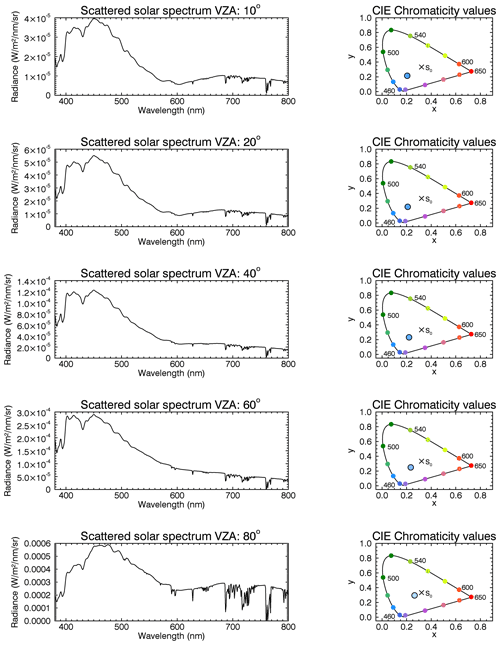
Figure 5Solar scattering spectra (left column) and CIE chromaticity diagrams (right column) for an observer on the Earth's surface and for a SZA of 98∘ and VZAs of 10, 20, 40, 60 and 80∘ (from top to bottom) and a SAA of 0∘, including NLCs with an optical depth of 10−4 at an altitude of 82 km.
3.2 Impact of ozone absorption
As evident from the spectra in Fig. 3, ozone absorption may also affect the colour of noctilucent clouds. The effect of ozone was already investigated by Gadsden (1975a), who made measurements of the spectral radiance of NLCs with a photoelectric spectropolarimeter. Figure 7 shows a CIE chromaticity diagram including NLCs and different ozone column densities.

Figure 7CIE chromaticity diagram for spectra including NLCs and different ozone column densities. Marked at the data points are the following: VZAs=45, 65 and 85∘, with and . The NLC parameters are as for the left panel of Fig. 3, i.e. rm=50 nm, S=1.4, and zNLC=82 km. Panel (b) shows an enlarged version.
For a vertical ozone column density of 300 DU, the colour changes with the VZAs (45, 65 and 85∘) from dark blue to light blue. This corresponds to a natural colour gradient of NLCs during twilight. With more ozone (600 DU), a shift of colours to smaller x values, i.e. a blue shift, can be observed. With a lower ozone column density (100 DU), a shift to larger x values occurs. This can be explained by the effect of ozone absorption in the Chappuis bands. Due to the long light path through the atmosphere, green, yellow, orange and short-wave red light is effectively absorbed by ozone, so blue light predominates. With more ozone, this effect is intensified and leads to a more saturated blue colour (compare 600 DU). However, a noticeable colour change only occurs at a low ozone column density (100 DU). This is due to the lower attenuation of the long-wave light by ozone absorption, resulting in a shift to the reddish region of the gamut (see ). In addition, the effect of ozone absorption increases for larger VZAs, due to the longer path through the ozone layer from the observer to the NLC. Since the changes in colour and the positions in the CIE chromaticity diagram corresponding to the different ozone column densities are closer together, it requires an unrealistically small amount of ozone for the colour of the NLCs to change. Nevertheless, ozone absorption must be taken into account to explain the colour of noctilucent clouds.
3.3 The role of particle size
The typical particle radii of visible NLCs are in the range of 10–80 nm (see Sect. 1). In order to test the effect of the NLC particle size on the colour of the clouds, we performed SCIATRAN simulations for different median radii of the assumed mono-modal log-normal particle size distribution, i.e. 10, 50, 200, 600 and 1000 nm. The width parameter is kept constant at S=1.4, and the optical depth was assumed to be in all cases. Figure 8 shows a chromaticity diagram with simulated colours for increasing particle sizes.
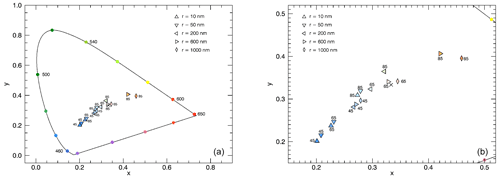
Figure 8CIE chromaticity diagram for simulations with NLCs and different median radii of the NLC particle size distribution. Marked at the data points are the following: VZAs=45, 65 and 85∘, with and . The width parameter of the size distribution is S=1.4, and the optical depth is . Panel (b) shows an enlarged version.
As expected, solar radiation scattered by particles with typical radii (10 to 50 nm) is perceived as blue by a ground-based observer. In addition, these radii also show the colour change from dark blue to white blue or light blue with the VZAs (45, 65 and 85∘). Assuming significantly larger particles, the scattered light becomes more reddish (compare 600 and 1000 nm). That means, when the particles become larger and scatter spectrally more neutral, the reddish colouring is also visible from the Earth's surface. Most of the calculations by Ostdiek and Thomas (1993), who have summarised various NLC measurements, are in agreement with our results, only in one case do their calculations show smaller particles in the yellowish/orange region of the CIE chromaticity diagram. The simulations displayed in Fig. 8 show that the typical colour of NLCs is only present for certain particle sizes. Furthermore, it can be shown that the light scattered by NLCs in the visible spectral range contains important information on the size of NLC particles. Thus, very large particles can be excluded by the resulting colour.
3.4 Influence near the horizon
During sunset, a reddening appears on the horizon (see Fig. 9), which accompanies most NLC observations (depending on the SZA). Figures 10 and 11 show simulated solar scattering spectra (left column) with the resulting colour impression (right column) for a ground-based observer with ; VZA=84, 87, and 90∘ (from top to bottom); and . Figure 10 shows the calculated results for NLCs with the following parameters: rm=50 nm, S=1.4, vertical optical depth of and an altitude of zNLC=82 km. In comparison, Fig. 11 illustrates the background without NLCs.
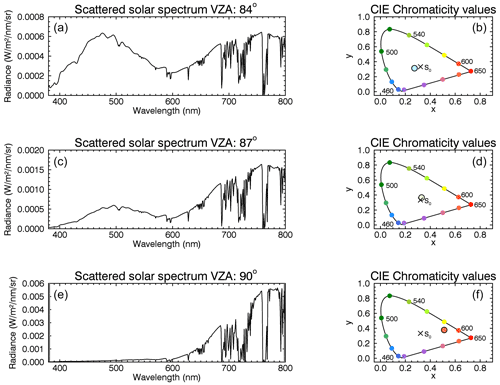
Figure 10Solar scattering spectra (a, c, e) and CIE chromaticity diagrams (b, d, f) for an observer on the Earth's surface and for ; VZA=84, 87, and 90∘ (from top to bottom); and . The simulations are calculated for NLCs with the following parameters: rm=50 nm, S=1.4, and zNLC=82 km.
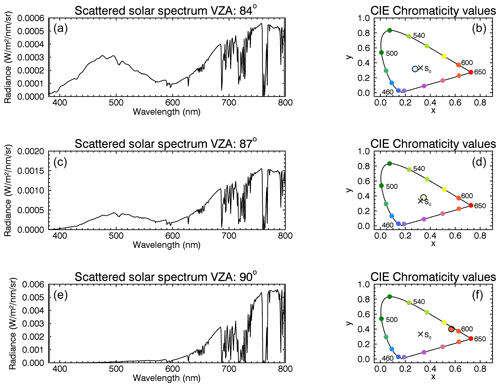
Figure 11Solar scattering spectra (a, c, e) and CIE chromaticity diagrams (b, d, f) for an observer on the Earth's surface and for ; VZA=84, 87, and 90∘ (from top to bottom); and . The calculated spectra show the background without NLCs.
Both plots depict the colour change from blue to orange near the horizon. Note here that the radiance values of the maximum in the short-wave blue spectral range at about 470 nm are larger for the simulations with NLCs than for the background case, especially for (upper panel). This results in different positions in the CIE chromaticity diagram. In contrast, the spectra for (lower panel) show no significant differences. Due to the very small radiance values for the case with NLCs in the range of about 400 nm, the positions in the CIE chromaticity diagram differ but not the resulting colour impression of orange. Since the simulated spectra near the horizon barely deviate in intensity and spectral shape, it can be concluded, as expected, that NLCs play no decisive role in the red colouring of the horizon. It should be noted that the tropospheric aerosol loading is highly variable, and the colours of the twilight sky may differ. But the main point here is the effect of NLCs on the reddish colour of the horizon.
3.5 Multiple scattering vs. single scattering
In earlier studies on simulations of the spectral distribution of solar radiation scattered by NLC particles, the contribution of multiply scattered radiation has been neglected (e.g. Gadsden, 1975a; Ostdiek and Thomas, 1993). Using SCIATRAN, the contribution of multiple scattering to the NLC spectra as seen by a ground-based observer can be easily simulated. For calculations with a more accurate consideration of multiple scattering, which is referred to as the fully spherical solution, i.e. “number of iterations” >1 (see Sect. 3), SCIATRAN version 4.5.5 is now used. Figure 12 shows the difference between both methods for scattered solar spectra with (left panel) and the ratio for different VZAs (right panel).

Figure 12(a) Solar scattering spectra for calculated with the exact method (black line) and the approximate method (red line). (b) Ratio of the exact method and the approximate method for different VZAs. For all simulations, and . The NLC parameters are the following: rm=50 nm, S=1.4, and zNLC=82 km.
The differences are mainly in the short-wave blue spectral range (maximum factor of 1.34). Overall, they are not crucial in the context of the current study. This is especially the case for the NLC-viewing geometry relevant VZAs here (45, 65 and 85∘). Furthermore, Fig. 13 shows that the more accurate consideration of multiple scattering has no visible effect on the CIE chromaticity values and the resulting colour, which is due to the blue CIE colour-matching function having its maximum at 450 nm. Therefore, the approximate multiple scattering treatment method is sufficient for the simulations performed here.
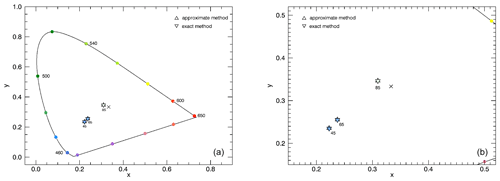
Figure 13CIE chromaticity diagram for simulations with NLCs considering different methods for treating multiple scattering. Marked at the data points are the following: VZAs=45, 65 and 85∘, with and . The NLC parameters are the following: rm=50 nm, S=1.4, and zNLC=82 km. Panel (b) shows an enlarged version.
In comparison, Fig. 14 shows CIE chromaticity values for different viewing geometries (VZAs of 45, 65, 85∘ and SZA of 98∘) and for single and multiple scattering simulations. For the calculations considering multiple scattering, the fully spherical solution was used here. The simulations show that for multiple scattering the colour is slightly bluer than for single scattering. This is due to Rayleigh scattering and the resulting preference for the short-wave blue light. However, no significant differences are observed.

Figure 14CIE chromaticity diagram for simulations with NLCs considering multiple scattering and single scattering only. Marked at the data points are the following: VZAs=45, 65 and 85∘, with and . The NLC parameters are the following: rm=50 nm, S=1.4, and zNLC=82 km. Panel (b) shows an enlarged version.
The spectra in Fig. 15 (left panel) show the simulated spectral distribution with and without the multiple scattering contribution for . The right panel compares the ratio of multiple scattering and single scattering for different VZAs.

Figure 15(a) Solar scattering spectra for with the multiple scattering (black line) and without the multiple scattering contribution to the total scattered radiance (red line). (b) Ratio of multiple scattering and single scattering for different VZAs. For all simulations, and . The NLC parameters are the following: rm=50 nm, S=1.4, and zNLC=82 km.
The scattered solar spectra show that for the single scattering the simulated values are smaller than for the multiple scattering (the maximum relative difference between the two spectra is 23 %). Especially in the short-wave range, the influence of multiple scattering is significant. Overall, the differences for the VZAs of the NLC-viewing geometry used here are not significant with respect to the focus of this study and confirm the results of Fig. 14. As above, the weak influence of the large differences at shorter wavelengths (compare Fig. 14) is due to the blue CIE colour-matching function with a maximum at 450 nm. However, the differences depend highly on the VZA. Near the zenith, multiple scattering has a large influence and results in a maximum factor of about 3.
Single scattering is a valid approximation for the NLC-viewing geometry used here, but it should be noted that, depending on the relevant VZA range, the effect of multiple scattering may dominate and lead to different conclusions.
We begin with a discussion of the limitations of the approach and results presented in this study, followed by a summary of how our results compare to the few earlier studies on the colour of NLCs.
Currently the study is limited to solar elevation , which covers about 40 % of all NLCs (Baumgarten et al., 2009, Fig. 3) due to the SZA limitation in SCIATRAN version 4.1.3. In the future we want to study non-spherical particles (Baumgarten et al., 2002; Hervig et al., 2009); however, we do not expect a qualitative change of our results since previous studies have shown only little effect on colour ratios (Kiliani et al., 2015).
It also should be kept in mind that only the position of a given spectrum in the CIE chromaticity diagram provides objective information on the associated colour. The colours of the symbols displayed in the chromaticity diagrams depend on the details of the calculation of the RGB values and will vary to a certain extent between different output devices.
To study the conditions of NLC illumination by the Sun and the influence of ozone for different viewing geometries, the local solar zenith angle (SZAL), i.e. the solar zenith angle at the location of the NLC can also be used. NLCs in different parts of the sky have different SZAL resulting in different effects of ozone. This means that each VZA corresponds to a different SZAL. For NLCs in the zenith, this value is equal to the SZA. For the NLC-viewing geometries used in this work, the effects and conclusions described in Sect. 3.1 remain unchanged with the consideration of the SZAL. However, for different geometries and observations, the use of the SZAL can be helpful.
In their work, Ostdiek and Thomas (1993) investigated the effect of two different NLC particle size distributions on the chromaticity values of NLC scattering spectra. The distributions were (1) a mono-modal log-normal distribution with an effective radius of 42.6 nm and (2) a power law distribution with an effective radius of about 700 nm. In good qualitative agreement with our results, the population of small particles leads to positions in the blue part of the chromaticity diagram, whereas the population of large particles leads to yellowish colours. Ostdiek and Thomas (1993) neglect refraction, and Gadsden (1975b) considers it but argues that its effect is very small. Ostdiek and Thomas (1993) mention that a test was carried out that showed that refraction does affect the radiance values but has a minor impact on the spectral shape of the scattering spectra and consequently also on the chromaticity values. Our simulations confirm the results of Ostdiek and Thomas (1993) (not shown).
Gadsden (1975a) also emphasised Chappuis absorption of ozone as a major factor influencing the colour of NLCs. However, our results show that for certain combinations of observation geometry and optical depth, ozone absorption is no longer visible and plays only a minor role for these cases.
Observations from July 2015 showed a polarisation value of the light scattered by NLCs close to 1 at scattering angles near 90∘ (Ugolnikov et al., 2016). This confirms the minor influence of multiple scattering and the valid approximation of single scattering.
In this work, various parameters that influence the colour of NLCs were investigated. Mie theory was used for the calculations; therefore, the assumption of spherical particles was made. To be able to make concrete conclusions about colour changes, the CIE chromaticity diagram was used.
First, an unrealistically small amount of ozone is required to observe a deviation from the typical blue colour of NLCs. A new result in this work is that for sufficiently large NLC optical depths and for specific viewing geometries, ozone plays only a minor role for the blueish colour of NLCs. Second, the particle size decisively determines the perceived colour of NLCs. From this it follows that the typical colour is only observable for certain particle sizes. Therefore, some information about the size of the particles can be derived from the colour of the scattered light in the visible spectral range. Third, NLCs do not influence the reddish colour of the horizon. Fourth, the difference between the single and the multiple scattering plays a negligible role for the perceived colour of NLC geometries considered in this study.
The SCIATRAN radiative transfer model can be accessed via the following link: https://www.iup.uni-bremen.de/sciatran/ (last access: 29 April 2022).
The solar spectrum can be accessed via the following link: http://lasp.colorado.edu/lisird/data/sorce_ssi_l3/ (last access: 29 April 2022, https://doi.org/10.5067/9PRENS3AL461, Woods et al., 2021).
AL and CvS outlined the project, and AL carried out the SCIATRAN simulations with guidance by AR. GB provided NLC photographs and his expertise on NLCs. AL wrote an initial version of the paper. All authors discussed, edited and proofread the paper.
The contact author has declared that neither they nor their co-authors have any competing interests.
Publisher's note: Copernicus Publications remains neutral with regard to jurisdictional claims in published maps and institutional affiliations.
The authors acknowledge financial support by the Deutsche Forschungsgemeinschaft and the University of Greifswald. This study was enabled by the collaborations within the DFG research unit Volimpact (FOR 2820, grant no. 398006378). We are indebted to the Institute of Environmental Physics of the University of Bremen – particularly to Vladimir Rozanov and John P. Burrows FRS – for access to the SCIATRAN radiative transfer model. We are thankful for the generous support by Jens Helmling of Calar Alto Astronomical Observatory in Spain in operating the southernmost camera of our European camera network. The work benefitted from the support by Michael Priester and citizen scientists in detecting NLCs in our camera observations.
This research has been supported by the Deutsche Forschungsgemeinschaft (grant no. 398006378).
This paper was edited by Igo Paulino and reviewed by two anonymous referees.
Avaste, O. A., Fedynsky, A. V., Grechko, G. M., Sevastyanov, V. I., and Willmann, Ch. I.: Advances in Noctilucent cloud research in the space era, Pure Appl. Geophys., 118, 528–580, 1980. a
Backhouse, T. W.: The luminous cirrus cloud of June and July, Meteorol. Mag., 20, 133 pp., 1885. a
Baumgarten, G. and Fiedler, J.: Vertical structure of particle properties and water content in noctilucent clouds, Geophys. Res. Lett., 35, L10811, https://doi.org/10.1029/2007GL033084, 2008. a, b, c
Baumgarten, G., Fricke, K. H., and von Cossart, G.: Investigation of the shape of noctilucent cloud particles by polarization lidar technique, Geophys. Res. Lett., 29, 8-1–8-4, https://doi.org/10.1029/2001GL013877, 2002. a
Baumgarten, G., Gerding, M., Kaifler, B., and Müller, N.: A trans-European network of cameras for observation of noctilucent clouds from 37∘ N to 69∘ N, in: Proceedings 19th ESA Symposium on European Rocket and Ballon Programmes and Related Research, Bad Reichenhall, Germany, 7–11 June 2009 (ESA SP-671, September 2009), 2009. a
Baumgarten, G., Fiedler, J., and Rapp, M.: On microphysical processes of noctilucent clouds (NLC): observations and modeling of mean and width of the particle size-distribution, Atmos. Chem. Phys., 10, 6661–6668, https://doi.org/10.5194/acp-10-6661-2010, 2010. a
Billmeyer Jr., F. W. and Fairman, H. S.: CIE Method For Calculating Tristimulus Values, Color Res. Appl., 12, 27–36, https://doi.org/10.1002/col.5080120106, 1987. a
Brainard, D. H. and Stockman, A.: Colorimetry, in: OSA Handbook of Optics, 3rd edn., edited by: Bass, M., McGraw-Hill, New York, 10.1–10.56, ISBN 13 9780071498913, 2010. a
Commission Internationale De L'Eclairage (CIE): CIE 15: 2004 – Colorimetry, 3rd edn., Technical Report, ISBN 3901906339, 2004. a, b
Currie, B. W.: The need for Canadian observations of noctilucent clouds, J. Roy. Astron. Soc. Can., 56, 141–147, 1962. a
Debrestian, D. J., Lumpe, J. D., Shettle, E. P., Bevilacqua, R. M., Olivero, J. J., Hornstein, J. S., Glaccum, W., Rusch, D. W., Randall, C. E., and Fromm, M. D.: An analysis of POAM II solar occultation observations of polar mesospheric clouds in the southern hemisphere, J. Geophys. Res., 102, 1971–1981, 1997. a
Fogle, B.: Recent advances in research on noctilucent clouds, B. Am. Meteorol. Soc., 41, 781–787, 1966. a
Gadsden, M.: Observations of the color and polarization of noctilucent clouds, Ann. Geophys., 31, 507–516, 1975a. a, b, c, d
Gadsden, M.: The colour of noctilucent clouds, Weather, 30, 190–197, https://doi.org/10.1002/j.1477-8696.1975.tb05292.x, 1975b. a, b, c, d
Gadsden, M. and Schröder, W.: Noctilucent clouds, Springer-Verlag, New York, USA, ISBN 0387506853, 1989. a, b
Grainger, R. G.: Some Useful Formulae for Aerosol Size Distributions and Optical Properties, Earth Observation Data Group, University of Oxford, available at: http://eodg.atm.ox.ac.uk/user/grainger/research/aerosols.pdf (last access: 29 April 2022), 2017. a
Gumbel, J. and Witt, G.: In situ measurements of the vertical structure of a noctilucent cloud, Geophys. Res. Lett., 25, 493–496, https://doi.org/10.1029/98GL00056, 1998. a
Hervig, M. E., Gordley, L. L., Stevens, M. H., Russell, J, M., Bailey, S. M., and Baumgarten, G.: Interpretation of SOFIE PMC measurements: Cloud identification and derivation of mass density, particle shape, and particle size, J. Atmos. Sol.-Terr. Phy., 71, 316–330, 2009. a
Hulburt, E. O.: Explanation of the Brightness and Color of the Sky, Particularly the Twilight Sky, J. Opt. Soc. Am., 43, 113–118, 1953. a
Judd, D. B.: Report of U. S. Secretariat Committee on Colorimetry and Artificial Daylight, in: Proceedings of the Twelfth Session of the CIE, Stockholm, Bureau Central de la CIE, Paris, 1, 11 pp., Paris, Bureau Central de la CIE, 1951. a
Kiliani, J., Baumgarten, G., Lübken, F.-J., and Berger, U.: Impact of particle shape on the morphology of noctilucent clouds, Atmos. Chem. Phys., 15, 12897–12907, https://doi.org/10.5194/acp-15-12897-2015, 2015. a
LASP (Laboratory for Atmospheric and Space Physics): SORCE Solar Spectral Irradiance, Spectrum, LASP Interactive Solar Irradiance Data Center (LISIRD), University of Colorado, http://lasp.colorado.edu/lisird/data/sorce_ssi_l3/ (last access: 29 April 2022), 2003. a, b
Leslie, R. C.: Sky glows, Nature, 32, 245 pp., 1885. a
Ostdiek, V. J. and Thomas, G. E.: Visible spectra and chromaticity of noctilucent clouds, J. Geophys. Res., 98, 20347–20356, https://doi.org/10.1029/93JD02180, 1993. a, b, c, d, e, f, g, h
Paton, J.: Noctilucent clouds, Meteorol. Mag., 93, 161–179, 1964. a
Rapp, M. and Thomas, G. E., Modeling the microphysics of mesospheric ice particles: Assessment of current capabilities and basic sensitivities, J. Atmos. Sol.-Terr. Phy., 68, 715–744, https://doi.org/10.1016/j.jastp.2005.10.015, 2006. a
Robert, C. E., von Savigny, C., Burrows, J. P., and Baumgarten, G.: Climatology of noctilucent cloud radii and occurrence frequency using SCIAMACHY, J. Atmos. Sol.-Terr. Phy., 71, 408–423, 2009. a
Rozanov, V., Rozanov, A., Kokhanovsky, A., and Burrows, J.: Radiative transfer through terrestrial atmosphere and ocean: Software package SCIATRAN, J. Quant. Spectrosc. Ra., 133, 13–71, 2014. a, b, c, d, e
Sinnhuber, B. M., Weber, M., Amankwah, A., and Burrows, J. P.: Total ozone during the unusual Antarctic winter of 2002, Geophys. Res. Lett., 30, 1580, https://doi.org/10.1029/2002GL016798, 2003. a
Thomas, G. E.: Mesospheric clouds and the physics of the mesopause region, Rev. Geophys., 29, 553–575, 1991. a
Thomas, G. E.: Climatology of Polar Mesospheric Clouds: Interannual Variability and Implications for Long-Term Trends, in: The Upper Mesosphere and Lower Thermosphere: A Review of Experiment and Theory, edited by: Johnson, R. M. and Killeen, T. L., Geophys. Monogr. Ser., 87, 185–200, https://doi.org/10.1029/GM087p0185, 1995. a
Ugolnikov, O. S., Maslov, I. A., Kozelov, B. V., and Dlugach, J. M.: Noctilucent cloud polarimetry: Twilight measurements in a wide range of scattering angles, Planet. Space Sci., 125, 105–113, 2016. a
von Savigny, C., Petelina, S. V., Karlsson, B., Llewellyn, E. J., Degenstein, D. A., Lloyd, N. D., and Burrows, J. P.: Vertical variation of NLC particle sizes retrieved from Odin/OSIRIS limb scattering observations, Geophys. Res. Lett., 32, L07806, https://doi.org/10.1029/2004GL021982, 2005. a
von Savigny, C., Baumgarten, G., and Lübken, F.-J.: Noctilucent Clouds: General Properties and Remote Sensing, in: Physics and Chemistry of the Arctic Atmosphere, edited by: Kokhanovsky, A. and Tomasi, C., Springer Polar Sciences, Springer, Cham, 469–504, https://doi.org/10.1007/978-3-030-33566-3_8, 2020. a
Vos, J. J.: Colorimetric and photometric properties of a 2-deg fundamental observer, Color Res. Appl., 3, 125–128, 1978. a
Woods, T., Harder, J., and Snow, M.: SORCE Combined XPS, SOLSTICE, and SIM Solar Spectral Irradiance 24-Hour Means V001, Greenbelt, MD, USA, Goddard Earth Sciences Data and Information Services Center (GES DISC) [data set], https://doi.org/10.5067/9PRENS3AL461, 2021 (data available at: http://lasp.colorado.edu/lisird/data/sorce_ssi_l3/, last access: 29 April 2022). a
Wullenweber, N., Lange, A., Rozanov, A., and von Savigny, C.: On the phenomenon of the blue sun, Clim. Past, 17, 969–983, https://doi.org/10.5194/cp-17-969-2021, 2021. a
Wyszecki, G. and Stiles, W. S.: Color Science – Concepts and Methods, Quantitative Data and Formulae, Wiley, New York, ISBN 978-0-471-39918-6, 2000. a, b








